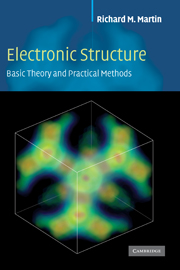Book contents
- Frontmatter
- Contents
- Preface
- Acknowledgments
- Notation
- Part I Overview and background topics
- Part II Density functional theory
- Part III Important preliminaries on atoms
- Part IV Determination of electronic structure: the three basic methods
- Part V Predicting properties of matter from electronic structure – recent developments
- 18 Quantum molecular dynamics (QMD)
- 19 Response functions: phonons, magnons, …
- 20 Excitation spectra and optical properties
- 21 Wannier functions
- 22 Polarization, localization, and Berry's phases
- 23 Locality and linear scaling O(N) methods
- 24 Where to find more
- Appendix A Functional equations
- Appendix B LSDA and GGA functionals
- Appendix C Adiabatic approximation
- Appendix D Response functions and Green's functions
- Appendix E Dielectric functions and optical properties
- Appendix F Coulomb interactions in extended systems
- Appendix G Stress from electronic structure
- Appendix H Energy and stress densities
- Appendix I Alternative force expressions
- Appendix J Scattering and phase shifts
- Appendix K Useful relations and formulas
- Appendix L Numerical methods
- Appendix M Iterative methods in electronic structure
- Appendix N Code for empirical pseudopotential and tight-binding
- Appendix O Units and conversion factors
- References
- Index
20 - Excitation spectra and optical properties
from Part V - Predicting properties of matter from electronic structure – recent developments
Published online by Cambridge University Press: 05 June 2012
- Frontmatter
- Contents
- Preface
- Acknowledgments
- Notation
- Part I Overview and background topics
- Part II Density functional theory
- Part III Important preliminaries on atoms
- Part IV Determination of electronic structure: the three basic methods
- Part V Predicting properties of matter from electronic structure – recent developments
- 18 Quantum molecular dynamics (QMD)
- 19 Response functions: phonons, magnons, …
- 20 Excitation spectra and optical properties
- 21 Wannier functions
- 22 Polarization, localization, and Berry's phases
- 23 Locality and linear scaling O(N) methods
- 24 Where to find more
- Appendix A Functional equations
- Appendix B LSDA and GGA functionals
- Appendix C Adiabatic approximation
- Appendix D Response functions and Green's functions
- Appendix E Dielectric functions and optical properties
- Appendix F Coulomb interactions in extended systems
- Appendix G Stress from electronic structure
- Appendix H Energy and stress densities
- Appendix I Alternative force expressions
- Appendix J Scattering and phase shifts
- Appendix K Useful relations and formulas
- Appendix L Numerical methods
- Appendix M Iterative methods in electronic structure
- Appendix N Code for empirical pseudopotential and tight-binding
- Appendix O Units and conversion factors
- References
- Index
Summary
Summary
Excitation spectra reveal the properties of matter in terms of the response to time- or frequency-dependent perturbations. Particularly important examples are the dielectric function ε(ω) and the inverse function ε−1(ω) defined in App. E. The basic formulas relating the response to the electronic structure are rooted in perturbation theory and response functions (Sec. 3.7 and App. D). This chapter is devoted to dynamic response functions for electrons in self-consistent field methods, such as the Kohn–Sham approach, and to the alternative approach of solving directly the time-dependent Kohn–Sham equation to find the solution to all orders. The formal structure is based upon time-dependent density functional theory (TDDFT) (Sec. 7.6), which provides an exact framework in principle. In practice, simple approximations are remarkably successful in many cases and there is active research to develop new functionals.
As emphasized in the overview, Sec. 2.10, two types of excitations are of primary importance for electronic structure: excitations in which an electron is added or subtracted from the system, and excitations in which the number of electrons remains fixed. The former are of great interest as the “one-electron excitations” in an interacting many-body system; however, in independent-particle theories, such as the Hartree–Fock or Kohn–Sham approaches, these excitations are just the eigenstates of the independent-particle hamiltonian. In a crystal, the eigenvalues form well-defined bands εik with none of the renormalization and broadening that can only be included in a many-body theory.
- Type
- Chapter
- Information
- Electronic StructureBasic Theory and Practical Methods, pp. 406 - 417Publisher: Cambridge University PressPrint publication year: 2004



